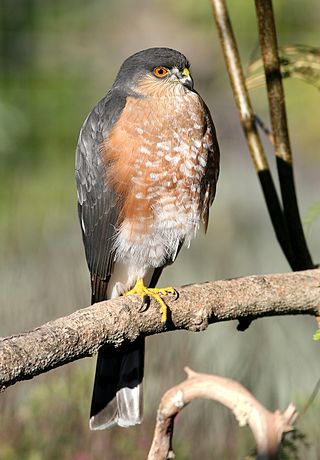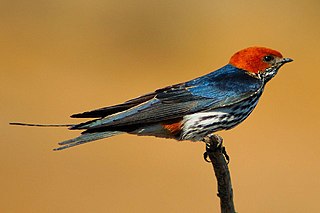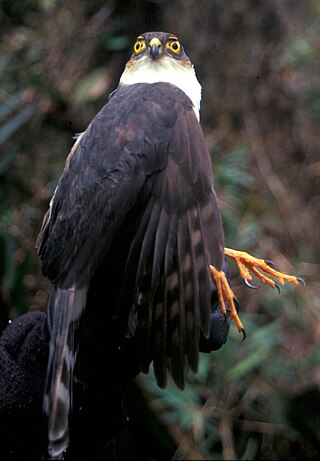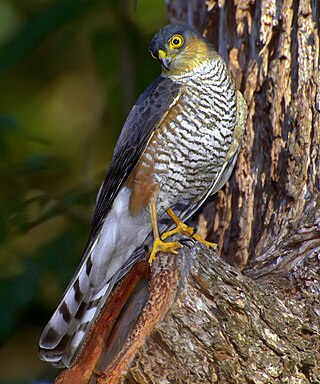
The blue-winged kookaburra is a large species of kingfisher native to northern Australia and southern New Guinea.

The sharp-shinned hawk or northern sharp-shinned hawk, commonly known as a sharpie, is a small hawk, with males being the smallest hawks in the United States and Canada, but with the species averaging larger than some Neotropical species, such as the tiny hawk. The taxonomy is far from resolved, with some authorities considering the southern taxa to represent three separate species: white-breasted hawk, plain-breasted hawk, and rufous-thighed hawk. The American Ornithological Society and some other checklists keeps all four variations conspecific.

The shikra is a small bird of prey in the family Accipitridae found widely distributed in Asia and Africa where it is also called the little banded goshawk. The African forms may represent a separate species but have usually been considered as subspecies of the shikra. The shikra is very similar in appearance, as well as behavior, at least to some degree, to other Accipiter species including the Chinese goshawk, Eurasian goshawk and Eurasian sparrowhawk. They have a sharp two note call and have the typical flap and glide flight. Their calls are imitated by drongos and the common hawk-cuckoo resembles it in plumage.

The red goshawk is probably the rarest Australian bird of prey. It is found mainly in the savanna woodlands of northern Australia, particularly near watercourses. It takes a broad range of live prey, mostly birds.

The Levant sparrowhawk is a small bird of prey. It measures 32–38 cm (13–15 in) in length with a wingspan of 65–75 cm (26–30 in). The female is larger than the male, but the difference is not as marked as with Eurasian sparrowhawk. The adult male is blue-grey above, with dark wingtips, and barred reddish below.

Frances's sparrowhawk is a small bird of prey. The nominate subspecies, A. f. francesiae, is endemic to Madagascar, and the other subspecies are found in the Comoro Islands. The Anjouan sparrowhawk, also known as the Anjouan Island sparrowhawk, Ndzuwani goshawk or Joanna Island goshawk, was thought to be extinct until searches in the 1980s and in 2005 confirmed that it is still extant.

The brown goshawk is a medium-sized bird of prey in the family Accipitridae found in Australia and surrounding islands.

The eastern (pale) chanting goshawk, or Somali chanting goshawk, is a bird of prey of East Africa.

The augur buzzard is a fairly large African bird of prey. This species is distinct in typical adult plumage for its blackish back, whitish underside and orange-red tail, while juvenile augur buzzards are generally rather brown in colour; however a dark morph is known, which causes the bird's entire body to become darker. This member of the Buteo genus is distributed in several parts of the central and southern Africa, normally being found from Ethiopia to southern Angola and central Namibia. It is resident and non-migratory throughout its range. This is a species of mountains, and adjacent savannah and grassland. This is a typical buteonine raptor, being a generalist predator which tends to prefer small mammals supplemented by reptiles and birds among various prey items.

The lesser striped swallow is a large swallow. It breeds in Sub-Saharan Africa from Sierra Leone and southern Sudan south into eastern South Africa. It is partially migratory with South African birds wintering further north. West African birds leave the north of the breeding range in the dry season.

The tiny hawk is a small diurnal bird of prey found in or near forests, primarily humid, throughout much of the Neotropics. It is primarily a bird-eater, and is known to prey on hummingbirds.

The blue quail or African blue quail is a species of bird in the family Phasianidae found in sub-Saharan Africa.

The bicolored hawk is a species of bird of prey in the family Accipitridae. It is found in forest, woodland, second growth, plantations, and wooded savanna in southeastern Mexico, Central America, and northern and central South America. Though generally uncommon, it is the most common species of Astur in most of its range, but it does not occur at altitudes above 2,700 metres (8,900 ft) such as the highest parts of the Andes.

The chestnut-flanked sparrowhawk is a small west African species of sparrowhawk in the family Accipitridae. This species was formerly placed in the genus Accipiter.

The red-thighed sparrowhawk, alternatively known as the red-legged sparrowhawk or western little sparrowhawk, is a species of sparrowhawk in the family Accipitridae from western and northern central Africa.

The little sparrowhawk is a species of Afrotropical bird of prey in the family Accipitridae. It is the smallest member of the genus Accipiter and forms a superspecies with the red-thighed sparrowhawk.

The rufous-breasted sparrowhawk, also known as the rufous-chested sparrowhawk and as the red-breasted sparrowhawk, is a species of bird of prey in the family Accipitridae. It is found in Angola, Democratic Republic of the Congo, Eritrea, Eswatini, Ethiopia, Kenya, Lesotho, Malawi, Mozambique, Rwanda, South Africa, South Sudan, Tanzania, Uganda, Zambia, and Zimbabwe.

The African goshawk is an African species of bird of prey in the genus Aerospiza. This species was formerly placed in the genus Accipiter.

The plain-breasted hawk is a small hawk described from Venezuela to western Bolivia. It is usually considered a subspecies of the sharp-shinned hawk by most taxonomists, including the American Ornithological Society, but the taxonomy is far from resolved, with some authorities considering the southern taxa to represent three separate species: white-breasted hawk, plain-breasted hawk, and rufous-thighed hawk.

The rufous-thighed hawk is a small hawk found from southern Brazil and southeastern Bolivia to Paraguay, Uruguay and northern Argentina. It is usually considered a subspecies of the sharp-shinned hawk by most taxonomists, including the American Ornithological Society, but the taxonomy is far from resolved, with some authorities considering the southern taxa to represent three separate species: white-breasted hawk, plain-breasted hawk, and rufous-thighed hawk.





















